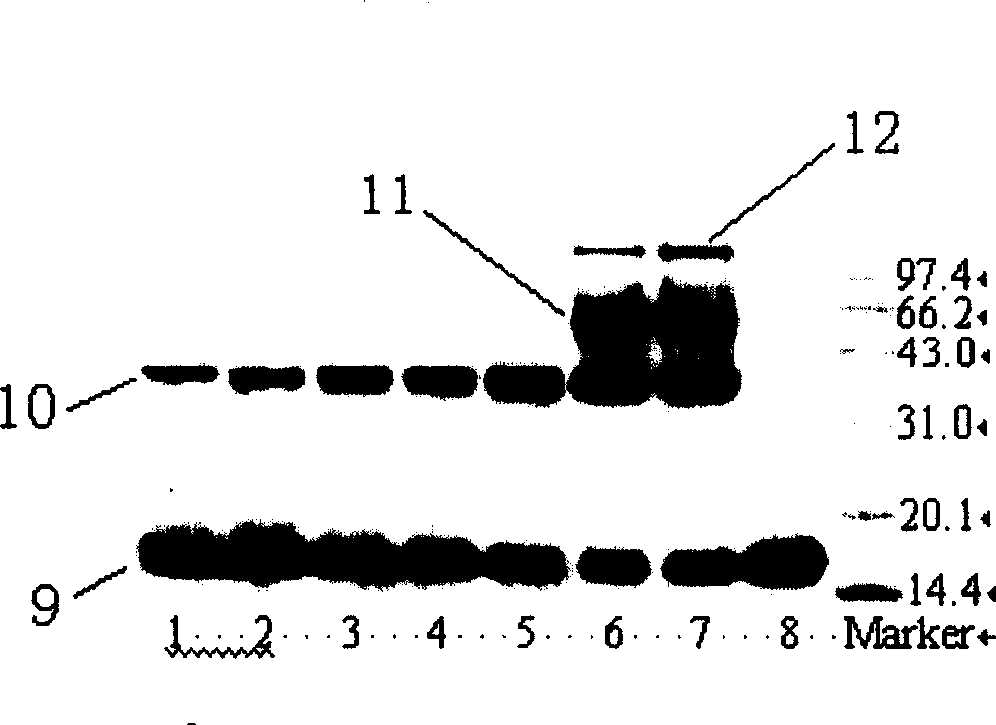Polyethyleneglycol acid or active ester connected to omega amino acid at their ends, preparation method and application
A technology of polyethylene glycol acid and polyethylene glycol, which is applied in the field of polyethylene glycol active ester and its preparation, can solve the problems of slow reaction and poor reactivity, and achieve the effect of easy separation
- Summary
- Abstract
- Description
- Claims
- Application Information
AI Technical Summary
Problems solved by technology
Method used
Image
Examples
Embodiment 1
[0044] MPEG-CH with a molecular weight of 5kD 2 CONH-CH 2 CH 2 Synthesis of COONHS
[0045] Step 1: Preparation of CM-PEG (carboxymethylated polyethylene glycol):
[0046]Dissolve 10g (2 mmol) of monomethoxy polyethylene glycol (diol) with a molecular weight of 5kD in toluene, distill a part of the toluene to azeotropically remove water, and then add 3 mmol of potassium tert-butoxide for reflux reaction 1.5h, then slowly add 3 millimoles of ethyl bromoacetate to reflux for 3h, then react at room temperature for 21h, filter to remove the precipitate, evaporate the solvent under reduced pressure, add a small amount of dichloromethane to dissolve the residue, and precipitate the product with dry ether. The product was dissolved in deionized water, and 0.1 mol / L sodium hydroxide solution was added until the pH value of the solution stabilized at pH 10, then the pH of the solution was adjusted to 3 with 0.1 mol / L hydrochloric acid, and the solution was extracted three times with the sa...
Embodiment 2
[0059] Synthesize mPEG-CH with a molecular weight of 12kD 2 CONH-CH 2 CH 2 CH 2 COOH
[0060] step 1:
[0061] Preparation of CM-PEG (carboxymethylated polyethylene glycol):
[0062] Dissolve 12g (1 mmol) of monomethoxy polyethylene glycol with a molecular weight of 12kD in an appropriate amount of toluene, distill a part of the toluene to azeotropically remove water, and then add 2 mmol of potassium tert-butoxide and reflux for 2h. Then slowly add 2 millimoles of ethyl bromoacetate to reflux for 4 hours, then react at room temperature for 18 hours, filter to remove the precipitate and evaporate the solvent under reduced pressure. The residue is dissolved in dichloromethane, and the product is precipitated with dry ether. The product is dissolved in In deionized water, gradually add 0.1 mol / L sodium hydroxide solution until the pH of the solution stabilizes at pH 10, then adjust the pH of the solution to 3 with 0.1 mol / L hydrochloric acid, extract the solution three times with the...
Embodiment 3
[0073] Synthesis of mPEG-CH with a molecular weight of 20kD 2 CONH-(CH 2 ) 5 COOH
[0074] step 1:
[0075] Preparation of CM-PEG (carboxymethylated polyethylene glycol):
[0076] Dissolve 20g (1 mmol) of monomethoxy polyethylene glycol with a molecular weight of 20kD in an appropriate amount of toluene, distill a part of the toluene to azeotropically remove water, and then add 3 mmol of potassium tert-butoxide and reflux for 2h. Then slowly add 1.5 millimoles of ethyl bromoacetate to reflux for 4 hours, and then react at room temperature for 24 hours. After filtering to remove the precipitate, the solvent is evaporated under reduced pressure. The residue is dissolved by adding a small amount of dichloromethane, and the product is precipitated with dry ether. In deionized water, gradually add 0.1 mol / L sodium hydroxide solution until the pH of the solution stabilizes at pH 11, then adjust the pH of the solution to 3 with 0.1 mol / L hydrochloric acid, extract the solution three time...
PUM
| Property | Measurement | Unit |
|---|---|---|
| Molecular weight | aaaaa | aaaaa |
Abstract
Description
Claims
Application Information
 Login to View More
Login to View More - R&D
- Intellectual Property
- Life Sciences
- Materials
- Tech Scout
- Unparalleled Data Quality
- Higher Quality Content
- 60% Fewer Hallucinations
Browse by: Latest US Patents, China's latest patents, Technical Efficacy Thesaurus, Application Domain, Technology Topic, Popular Technical Reports.
© 2025 PatSnap. All rights reserved.Legal|Privacy policy|Modern Slavery Act Transparency Statement|Sitemap|About US| Contact US: help@patsnap.com

